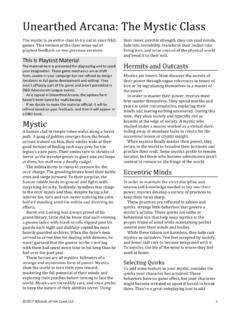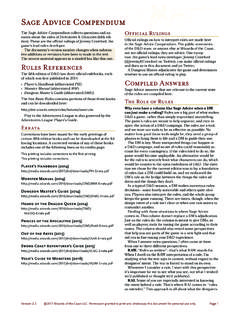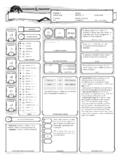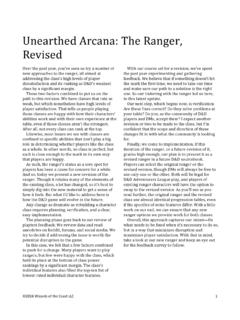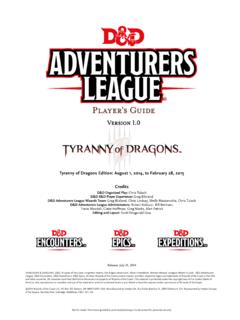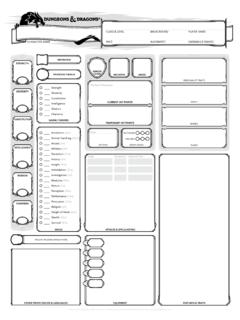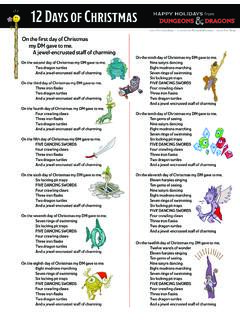Transcription of Dungeon Master’s Basic Rules Version 0 - Wizards …
1 Dungeon master s Basic Rules Version D&D Lead Designers: Mike Mearls, Jeremy CrawfordDesign Team: Christopher Perkins, James Wyatt, Rodney Thompson, Robert J. Schwalb, Peter Lee, Steve Townshend, Bruce R. CordellEditing Team: Chris Sims, Michele Carter, Scott Fitzgerald GrayProducer: Greg BilslandArt Directors: Kate Irwin, Dan Gelon, Jon Schindehette, Mari Kolkowsky, Melissa Rapier, Shauna NarcisoGraphic Designers: Bree Heiss, Emi TanjiInterior Illustrator: Jaime Jones Additional Contributors: Kim Mohan, Matt Sernett, Chris Dupuis, Tom LaPille, Chris Tulach, Miranda Horner, Jennifer Clarke Wilkes, Steve Winter, Chris Youngs, Ben Petrisor, Tom OlsenProject Management: Neil Shinkle, Kim Graham, John HayProduction Services: Cynda Callaway, Brian Dumas, Jefferson Dunlap, Anita WilliamsBrand and Marketing.
2 Nathan Stewart, Liz Schuh, Chris Lindsay, Shelly Mazzanoble, Hilary Ross, Laura Tommervik, Kim Lundstrom, Trevor KiddRelease: December 21, 2015 DUNGEONS & DRAGONS, D&D, Wizards of the Coast, Forgotten Realms, the dragon ampersand, Player s Handbook, Monster Manual, Dungeon master s Guide, all other Wizards of the Coast product names, and their respective logos are trademarks of Wizards of the Coast in the USA and other countries. All characters and their distinctive likenesses are property of Wizards of the Coast. This material is protected under the copyright laws of the United States of America. Any reproduction or unauthorized use of the material or artwork contained herein is prohibited without the express written permission of Wizards of the Coast.
3 2015 Wizards of the Coast LLC, PO Box 707, Renton, WA 98057-0707, USA. Manufactured by Hasbro SA, Rue Emile-Bo chat 31, 2800 Del mont, CH. Represented by Hasbro Europe, 4 The Square, Stockley Park, Uxbridge, Middlesex, UB11 1ET, on the original D&D game created by E. Gary Gygax and Dave Arneson, with Brian Blume, Rob Kuntz, James Ward, and Don KayeDrawing from further development by J. Eric Holmes, Tom Moldvay, Frank Mentzer, Aaron Allston, Harold Johnson, David Zeb Cook, Ed Greenwood, Keith Baker, Tracy Hickman, Margaret Weis, Douglas Niles, Jeff Grubb, Jonathan Tweet, Monte Cook, Skip Williams, Richard Baker, Peter Adkison, Bill Slavicsek, Andy Collins, and Rob HeinsooPlaytesting provided by over 175,000 fans of D&D.
4 Thank you!Available for download at DM s Basic Rules | MonstersNot for resale. Permission granted to print and photocopy this document for personal use for understanding the information found in a monster s statistics are presented monster s statistics, sometimes referred to as its stat block, provide the essential information that you need to run the monster can be Tiny, Small, Medium, Large, Huge, or Gargantuan. The Size Categories table shows how much space a creature of a particular size controls in combat. See the player s D&D Basic Rules or the Player s Handbook for more information on creature size and CategoriesSizeSpaceExamplesTiny2 by 2 , spriteSmall5 by 5 rat, goblinMedium5 by 5 , werewolfLarge10 by 10 , ogreHuge15 by 15 giant, treantGargantuan20 by 20 ft.
5 Or largerKraken, purple wormTypeA monster s type speaks to its fundamental nature. Certain spells, magic items, class features, and other effects in the game interact in special ways with creatures of a particular type. For example, an arrow of dragon slaying deals extra damage not only to dragons but also other creatures of the dragon type, such as dragon turtles and wyverns. The game includes the following monster types, which have no Rules of their own. Aberrations are utterly alien beings. Many of them have innate magical abilities drawn from the creature s alien mind rather than the mystical forces of the world. The quintessential aberrations are aboleths, beholders, mind flayers, and slaadi.
6 Beasts are nonhumanoid creatures that are a natural part of the fantasy ecology. Some of them have magical powers, but most are unintelligent and lack any society or language. Beasts include all varieties of ordinary animals, dinosaurs, and giant versions of animals. Celestials are creatures native to the Upper Planes. Many of them are the servants of deities, employed as messengers or agents in the mortal realm and throughout the planes. Celestials are good by nature, so the exceptional celestial who strays from a good alignment is a horrifying rarity. Celestials include angels, couatls, and pegasi. Constructs are made, not born. Some are programmed by their creators to follow a simple set of instructions, while others are imbued with sentience and capable of independent thought.
7 Golems are the iconic constructs. Many creatures native to the outer plane of Mechanus, such as modrons, are constructs shaped from the raw material of the plane by the will of more powerful creatures. Dragons are large reptilian creatures of ancient origin and tremendous power. True dragons, including the good metallic dragons and the evil chromatic dragons, are highly intelligent and have innate magic. Also in this category are creatures distantly related to true dragons, but less powerful, less intelligent, and less magical, such as wyverns and pseudodragons. Elementals are creatures native to the elemental planes. Some creatures of this type are little more than animate masses of their respective elements, including the creatures simply called elementals.
8 Others have biological forms infused with elemental energy. The races of genies, including djinn and efreet, form the most important civilizations on the elemental planes. Other elemental creatures include azers, invisible stalkers, and water weirds. Fey are magical creatures closely tied to the forces of nature. They dwell in twilight groves and misty forests. In some worlds, they are closely tied to the Feywild, also called the Plane of Faerie. Some are also found in the Outer Planes, particularly the planes of Arborea and the Beastlands. Fey include dryads, pixies, and satyrs. Fiends are creatures of wickedness that are native to the Lower Planes. A few are the servants of deities, but many more labor under the leadership of archdevils and demon princes.
9 Evil priests and mages sometimes summon fiends to the material world to do their bidding. If an evil celestial is a rarity, a good fiend is almost inconceivable. Fiends include demons, devils, hell hounds, rakshasas, and yugoloths. Giants tower over humans and their kind. They are humanlike in shape, though some have multiple heads (ettins) or deformities (fomorians). The six varieties of true giant are hill giants, stone giants, frost giants, fire giants, cloud giants, and storm giants. Besides these, creatures such as ogres and trolls are giants. Humanoids are the main peoples of the D&D world, both civilized and savage, including humans and a tremendous variety of other species.
10 They have language and culture, few if any innate magical abilities (though most humanoids can learn spellcasting), and a bipedal form. The most common humanoid races are the ones most suitable as player characters: humans, dwarves, elves, and halflings. Almost as numerous but far more savage and brutal, and almost uniformly evil, are the races of goblinoids (goblins, hobgoblins, and bugbears), orcs, gnolls, lizardfolk, and kobolds. Monstrosities are monsters in the strictest sense frightening creatures that are not ordinary, not truly natural, and almost never benign. Some are the results of magical experimentation gone awry (such as owlbears), and others are the product of terrible curses (including minotaurs and yuan-ti).
